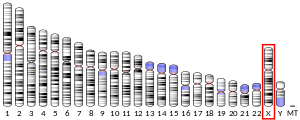GSPT2
Eukaryotic peptide chain release factor GTP-binding subunit ERF3B is an enzyme that in humans is encoded by the GSPT2 gene.[5][6]
GSPT2 is closely related to GSPT1 (MIM 139259), a GTP-binding protein that plays an essential role at the G1- to S-phase transition of the cell cycle in yeast and human cells. GSPT1 is a positive regulator of translational accuracy and, in a binary complex with eRF1 (MIM 600285), functions as a polypeptide chain release factor.[supplied by OMIM][6]
Interactions
GSPT2 has been shown to interact with PABPC1.[7]
gollark: Your birthday present will be NOT bees.
gollark: Ideatic idea: implement the AQA exam pseudocode language.
gollark: "Almost-maybe-working" because it doesn't *actually* exactly match stuff.
gollark: [BEES EXPUNGED]
gollark: Hey, maybe I can use the almost-working-maybe auction valuation function in order to narrow down candidates for actually sending to the server.
References
- GRCh38: Ensembl release 89: ENSG00000189369 - Ensembl, May 2017
- GRCm38: Ensembl release 89: ENSMUSG00000071723 - Ensembl, May 2017
- "Human PubMed Reference:". National Center for Biotechnology Information, U.S. National Library of Medicine.
- "Mouse PubMed Reference:". National Center for Biotechnology Information, U.S. National Library of Medicine.
- Hansen LL, Jakobsen CG, Justesen J (Jan 2000). "Assignment of the human peptide chain release factor 3 (GSPT2) to Xp11.23→p11.21 and of the distal marker DXS1039 by radiation hybrid mapping". Cytogenet Cell Genet. 86 (3–4): 250–1. doi:10.1159/000015353. PMID 10575220.
- "Entrez Gene: GSPT2 G1 to S phase transition 2".
- Hoshino, S; Imai M; Kobayashi T; Uchida N; Katada T (Jun 1999). "The eukaryotic polypeptide chain releasing factor (eRF3/GSPT) carrying the translation termination signal to the 3'-Poly(A) tail of mRNA. Direct association of erf3/GSPT with polyadenylate-binding protein". J. Biol. Chem. UNITED STATES. 274 (24): 16677–80. doi:10.1074/jbc.274.24.16677. ISSN 0021-9258. PMID 10358005.
Further reading
- Rual JF, Venkatesan K, Hao T, et al. (2005). "Towards a proteome-scale map of the human protein-protein interaction network". Nature. 437 (7062): 1173–8. Bibcode:2005Natur.437.1173R. doi:10.1038/nature04209. PMID 16189514.
- Chauvin C, Salhi S, Le Goff C, et al. (2005). "Involvement of Human Release Factors eRF3a and eRF3b in Translation Termination and Regulation of the Termination Complex Formation". Mol. Cell. Biol. 25 (14): 5801–11. doi:10.1128/MCB.25.14.5801-5811.2005. PMC 1168810. PMID 15987998.
- Ota T, Suzuki Y, Nishikawa T, et al. (2004). "Complete sequencing and characterization of 21,243 full-length human cDNAs". Nat. Genet. 36 (1): 40–5. doi:10.1038/ng1285. PMID 14702039.
- Strausberg RL, Feingold EA, Grouse LH, et al. (2003). "Generation and initial analysis of more than 15,000 full-length human and mouse cDNA sequences". Proc. Natl. Acad. Sci. U.S.A. 99 (26): 16899–903. Bibcode:2002PNAS...9916899M. doi:10.1073/pnas.242603899. PMC 139241. PMID 12477932.
- Le Goff C, Zemlyanko O, Moskalenko S, et al. (2003). "Mouse GSPT2, but not GSPT1, can substitute for yeast eRF3 in vivo". Genes Cells. 7 (10): 1043–57. doi:10.1046/j.1365-2443.2002.00585.x. PMID 12354098.
- Hoshino S, Imai M, Kobayashi T, et al. (1999). "The eukaryotic polypeptide chain releasing factor (eRF3/GSPT) carrying the translation termination signal to the 3'-Poly(A) tail of mRNA. Direct association of erf3/GSPT with polyadenylate-binding protein". J. Biol. Chem. 274 (24): 16677–80. doi:10.1074/jbc.274.24.16677. PMID 10358005.
- Hoshino S, Imai M, Mizutani M, et al. (1998). "Molecular cloning of a novel member of the eukaryotic polypeptide chain-releasing factors (eRF). Its identification as eRF3 interacting with eRF1". J. Biol. Chem. 273 (35): 22254–9. doi:10.1074/jbc.273.35.22254. PMID 9712840.
External links
- Overview of all the structural information available in the PDB for UniProt: Q8IYD1 (Human Eukaryotic peptide chain release factor GTP-binding subunit ERF3B (GSPT2)) at the PDBe-KB.
This article is issued from Wikipedia. The text is licensed under Creative Commons - Attribution - Sharealike. Additional terms may apply for the media files.




